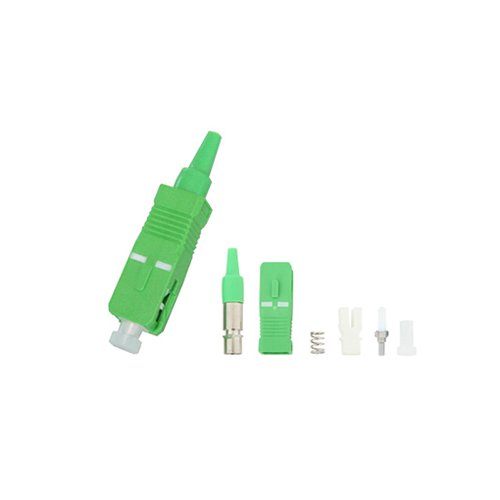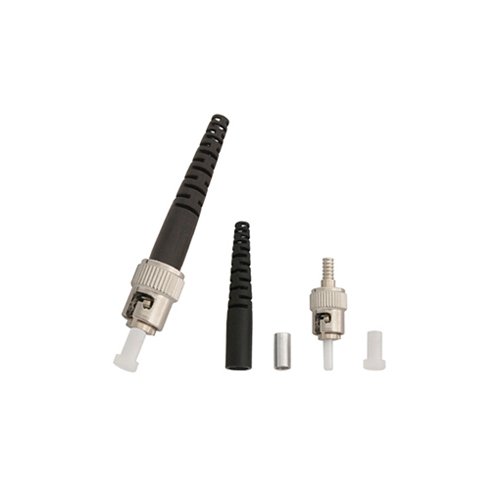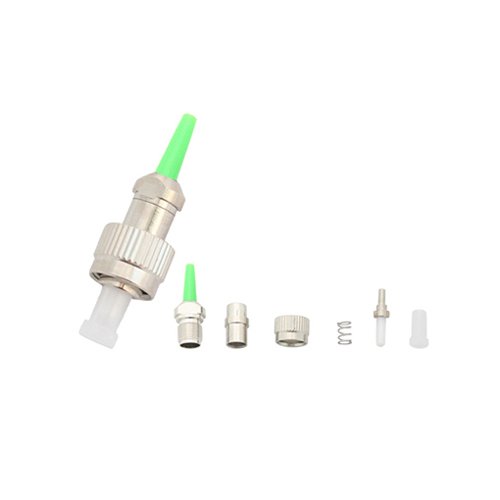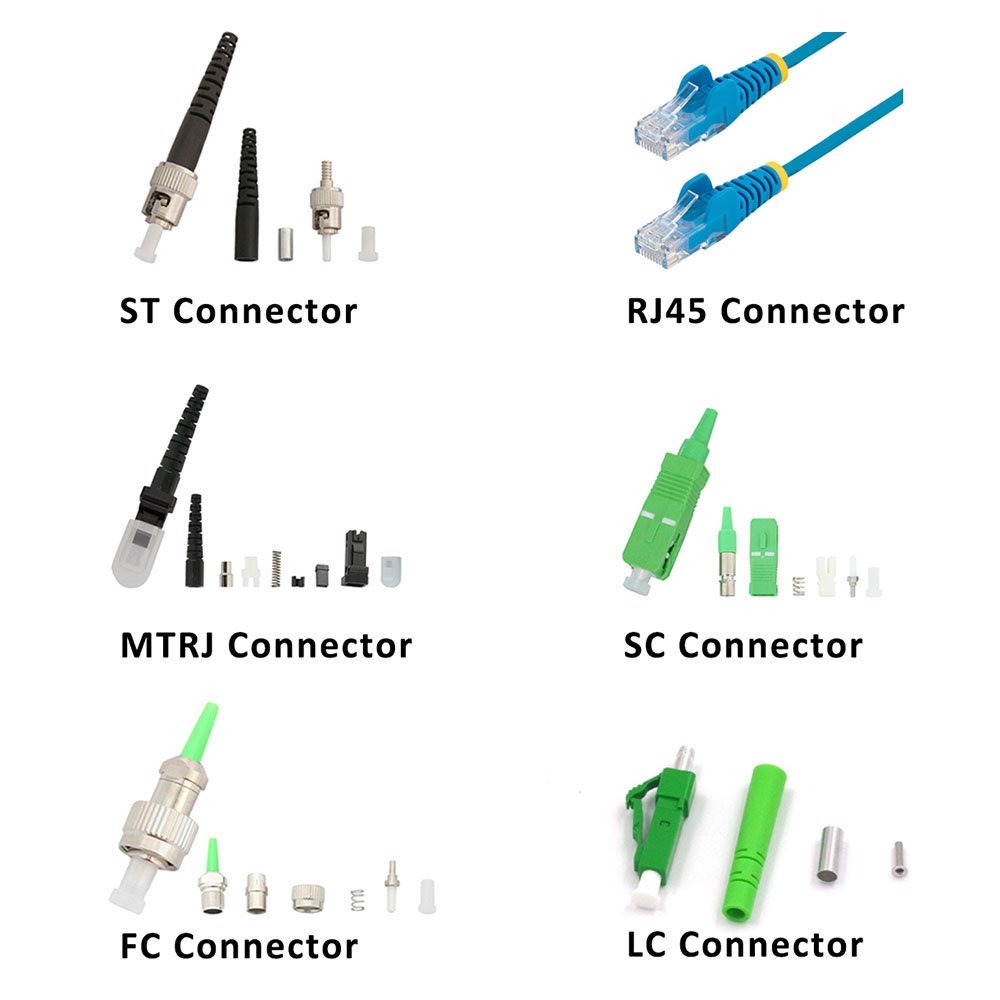Fiber Optic Connector Introduction
Imagine a world where data flows like a river, seamless and uninterrupted, powering everything from your home internet to massive data centers. At the heart of this flow are fiber optic connectors—small but mighty heroes that link optical fibers together or to equipment, ensuring signals travel fast and clear. Whether you’re a network technician, a business owner upgrading your setup, or just curious about fiber optics, understanding the different fiber optic connector types is key to making smart choices.
In this guide, we’ll dive into the most popular optical connector types—LC, SC, ST, FC, and MTP/MPO. We’ll explore what makes each one tick, where they shine, and how they differ, using everyday analogies to keep things relatable. By the end, you’ll know which connector fits your needs, and we’ll point you to CommMesh, where high-quality solutions are just a click away at commmesh.com. Let’s get started!
LC Connector: The Compact Powerhouse
Think of the LC connector as the compact car of the fiber optic world—small, nimble, and perfect for squeezing into tight spaces. Developed by Lucent Technologies in the late 1990s, the LC (Lucent Connector) has become a go-to thanks to its tiny size and big performance.

What It Looks Like:
- Ferrule Diameter: 1.25 mm—half the size of many others.
- Latching Mechanism: A push-pull clip, like a seatbelt snapping into place.
Where You’ll Find It:
- Data centers, where space is gold.
- High-density patch panels.
- Gigabit Ethernet networks.
- Fiber-to-the-home (FTTH) setups bringing fast internet to your doorstep.
Variations (LC Connector Types):
- Simplex: One fiber, one lane.
- Duplex: Two fibers, like a two-way street.
- Polishing Options:
- PC (Physical Contact): Standard, with about 0.5 dB insertion loss.
- UPC (Ultra Physical Contact): Smoother finish, dropping loss to 0.3 dB.
- APC (Angled Physical Contact): Angled to cut back reflection, ideal for CATV.
Why It’s Great:
- Its small size fits more connections in less space—perfect for modern, crowded setups.
- Easy to snap in and out, saving time.
The Catch:
- That tiny size can make it fragile if you’re not careful.
Here’s a fun fact: According to Grand View Research, LC connectors grabbed a whopping 36.7% market share in 2022. That’s a testament to their popularity! At CommMesh, we offer LC Duplex connectors tailored for data centers, with stock items shipping in just 7 days. Check them out at www.commmesh.com.
SC Connector: The Reliable Workhorse
If LC is the compact car, the SC connector is the sturdy SUV—bigger, tougher, and ready for a variety of terrains. Introduced by NTT in the early 1990s, the SC (Subscriber Connector or Square Connector) has been a telecom staple for years.

What It Looks Like:
- Ferrule Diameter: 2.5 mm—twice the LC’s size.
- Latching Mechanism: Push-pull, smooth and simple.
Where You’ll Find It:
- Telecom networks carrying phone and internet signals.
- Passive Optical Networks (PONs) for broadband.
- Industrial settings needing durability.
- Older systems still kicking around.
Variations (SC Connector Types):
- Simplex or Duplex: One or two fibers.
- Polishing: PC, UPC, and APC, just like LC.
Why It’s Great:
- Built tough, it stands up to wear and tear.
- Quick to connect or disconnect, no fuss.
- Works across a wide range of applications.
The Catch:
- Its larger size isn’t ideal for super-tight, high-density spaces.
SC connectors might not steal the spotlight like LC, but they’re a dependable choice for many. They’re like that friend who’s always there when you need them—solid and steady.
ST Connector: The Classic Cruiser
Picture the ST connector as an old-school car with a manual gearshift—reliable and secure, but a bit slower to handle. Developed by AT&T in the 1980s, the ST (Straight Tip) was one of the first widely used connectors, and it still lingers in some setups.

What It Looks Like:
- Ferrule Diameter: 2.5 mm, like SC and FC.
- Latching Mechanism: Bayonet mount—you twist it to lock, like a camera lens.
Where You’ll Find It:
- Campus or enterprise networks from years past.
- Legacy systems that haven’t upgraded.
- Industrial spots needing a firm connection.
Variations:
- Simplex Only: One fiber at a time.
- Polishing: PC, UPC, APC options.
Why It’s Great:
- That twist-lock makes it super secure—once it’s in, it’s in.
- Tough enough for rough environments.
The Catch:
- Twisting takes longer than push-pull connectors.
- Its size doesn’t fit today’s high-density trends.
ST connectors are like vinyl records—loved by some for nostalgia, but newer options have largely taken over.
FC Connector: The Precision Specialist
The FC connector is the fine-tuned instrument of the bunch, like a violin in an orchestra—perfect for specific, high-precision jobs. Dating back to the 1970s, the FC (Ferrule Connector) was designed with stability in mind, especially for single-mode fibers.

What It Looks Like:
- Ferrule Diameter: 2.5 mm.
- Latching Mechanism: Threaded coupling—you screw it in, like tightening a jar lid.
Where You’ll Find It:
- Single-mode fiber setups for long-distance signals.
- Test equipment needing pinpoint accuracy.
- Industrial applications where stability trumps speed.
Variations:
- Simplex Only: One fiber.
- Polishing: PC, UPC, APC.
Why It’s Great:
- Rock-solid connection, minimizing signal loss.
- Low insertion loss for top performance.
- Perfect for precision tasks.
The Catch:
- Screwing it in and out takes time—patience required!
- Not practical for frequent changes.
FC connectors are a niche player today, but they excel where steady performance matters most.
MTP/MPO Connector: The High-Speed Hauler
Now, imagine the MTP/MPO connector as a high-speed train, carrying multiple passengers—or in this case, fibers—at once. Developed by US Conec in the late 1990s, MTP/MPO (Multi-fiber Push-on) is built for today’s data-hungry world.

What It Looks Like:
- Ferrule: Varies, holding 4, 8, 12, or more fibers.
- Latching Mechanism: Push-in latch, rectangular and sleek.
Where You’ll Find It:
- Data centers needing massive bandwidth.
- High-speed network backbones.
- Server rooms linking racks efficiently.
Variations:
- Fiber Count: 4, 8, 12, or more.
- Polishing: PC, UPC, APC.
Why It’s Great:
- Packs tons of fibers into a small space—efficiency at its best.
- Simplifies cabling in busy setups.
- Cuts installation time and clutter.
The Catch:
- More complex to make and install.
- Costs more upfront than single-fiber options.
With data demands soaring—think 5G and cloud computing—MTP/MPO is a rising star. CommMesh offers MTP/MPO connectors and MST boxes for high-density needs, with stock shipping in 7 days. See more at www.commmesh.com.
Comparing Fiber Optic Connector Types
To make sense of these options, here’s a quick comparison table:
| Connector Type | Ferrule Diameter | Latching Mechanism | Applications | Notes |
|---|---|---|---|---|
| LC | 1.25 mm | Clip or push-pull | Data centers, FTTH | Smallest, 36.7% market share |
| SC | 2.5 mm | Push-pull | Telecom, PONs | Robust, widely used |
| ST | 2.5 mm | Bayonet mount | Legacy systems | Secure but slower |
| FC | 2.5 mm | Threaded | Test equipment, single-mode | Stable, niche |
| MTP/MPO | Varies | Push-in | Data centers, backbones | Multi-fiber, high-density |
This snapshot shows how each connector fits different niches—LC for density, SC for versatility, ST for tradition, FC for precision, and MTP/MPO for scale.
How to Choose the Right Connector
Picking the perfect fiber connector type isn’t rocket science, but it does take some thought. Here’s what to consider:
- What’s Your Application?
- Speed and Distance: Single-mode (long distances, like FC) or multi-mode (shorter, like LC)?
- Environment: Dusty or wet? SC’s durability might win here.
- Space Constraints:
- Tight spots like data centers scream for LC or MTP/MPO.
- Roomier setups can handle SC or ST.
- Ease of Use:
- Push-pull connectors (LC, SC) are quick—like flipping a light switch.
- Bayonet (ST) or threaded (FC) are slower, like winding a clock.
- Budget:
- LC and SC are cost-effective for most.
- MTP/MPO’s upfront cost pays off in big, busy networks.
- Compatibility:
- Check your gear—does it need a specific type?
Let’s say you’re wiring a data center. You’d lean toward LC connector types for their size or MTP/MPO for multi-fiber efficiency. For a telecom upgrade, SC connector types might be your trusty pick. Match your needs, and you’re golden.

Why Fiber Optic Connectors Are Important
Fiber optic connectors aren’t just tech trivia—they’re the backbone of our connected world. From streaming your favorite shows to running global businesses, these little plugs keep data moving. And with trends like 5G and cloud computing pushing bandwidth needs higher, picking the right connector is more crucial than ever. LC’s dominance (36.7% market share, per Grand View Research) and MTP/MPO’s rise show where the industry’s heading—faster, denser, smarter.
Conclusion
Whether you’re drawn to the compact LC, the rugged SC, the classic ST, the precise FC, or the multi-tasking MTP/MPO, there’s a fiber optic connector type for every job. At CommMesh, we’ve got you covered with top-notch options like LC Duplex connectors for data centers and MTP/MPO solutions for high-speed networks—all FC-certified and ready to ship in 7 days for stock items. Curious? Explore our full range at www.commmesh.com and find the perfect fit for your next project. Let’s keep the data flowing!

